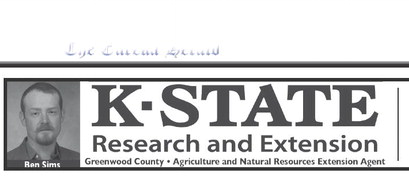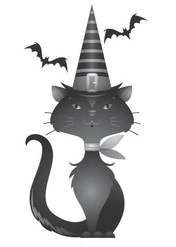K-STATE Research and Extension
Greenwood County ♦ Agriculture and Natural Resources Extension Agent
Eastern
Red Cedar Control
According to a K-State Research and Extension Agronomy eUpdate from Range Management Specialist Walt Fick, Eastern red cedar is an invasive coniferous tree found throughout much of Kansas. They are both male and female trees. Eastern red cedar has been commonly planted in shelterbelts. Birds undoubtedly eat the seeds and spread the plant along fence lines, under power lines, along roadsides, and in range and pasture land. Fall and early winter is a good time to start planning a control program for eastern red cedar on range and pasture in Kansas. The tree infests grasslands throughout the state. It can be especially common on rangeland or pasture that has not been burned for several years. If left uncontrolled, eastern red cedar can completely take over grasslands, intercepting rainfall and reducing forage production. The annual rate of red cedar invasion can be remarkable. Eastern red cedar is a non-sprouting plant. It does not re-sprout from belowground plant parts like hedge or honey locust. This simplifies the control measure, in some ways. There are three principal methods of controlling eastern red cedar. In order of preference, the methods are: prescribed burning, mechanical control, and chemical control.
Prescribed burning: Fire can kill or damage eastern red cedar if there is enough fuel to carry the fire. A normal fire will control red cedars that are less than three to four feet tall. It normally grows about 6-12 inches a year, so as long as grassland managers burn every 3 to 4 years, that should keep most or all of the red cedar under control. Fire may not kill the entire plant, but if at least two-thirds or three-fourths of the needles are scorched, the plants will eventually die. If only half or less of the needles are scorched, the plants will probably survive. The most difficult situations are when there is a thick stand of red cedar, or many of the plants are more than four feet tall. Under these conditions, fire will probably not be acceptably effective. Late summer rest should be used in grazing management to allow accumulation of enough fine fuel to ignite trees when the prescribed burn occurs. Smaller cedar trees can be cut and stacked under large trees.
They can serve as ladder fuels taking fire from the ground up into the canopy of larger trees.
Burning can take place just about any t i m e , but Febru- a r y to March might be ideal as trees are dry and seem to ignite easily. Timing of the prescribed burn depends on your objectives.
Mechanical control: Red cedars can be killed outright if they are clipped off near ground level, below the first green branch. Where clipping or mowing hasn’t been effective, it’s because the plants were not cut low enough. Even clipping three inches off the ground may not be low enough in some cases. Managers should try to get as close to ground level as possible. Clipping may be the only way of controlling eastern red cedar that is more than four feet tall. Clipping is sometimes easier to do if the plants have first been burned – even if the plants survived the fire.
If the fire was reasonably hot, it will almost always sear off many of the lower branches, which makes it easier to get to when operating a clipper, mower, or chainsaw. Eastern red cedar that is clipped off at the ground level will not regrow or re-sprout. Red cedar can be controlled by clipping or mowing at any time of the year.
Chemical control: If the stand of red cedar is too thick to get a good burn (or manager simply doesn’t want to do a prescribed burn) and the plants aren’t too big, then chemical control is another alternative. One chemical for eastern red cedar control is picloram, which is contained in Tordon 22K and Surmount. Tordont 22K can be applied as a liquid directly to the soil right at the base of the plant. The label calls for three to four milliliters, undiluted, per three feet of plant height. This could be applied in April/May or September/ October, just prior to a rain if possible.
It can also be applied as a foliar spray, in a one percent solution. Surmount is applied as a foliar spray to trees no more than three feet tall, at the rate of three to six pints per acre, in late spring or early summer. Tordon 22K and Surmount are restricted use pesticides and require an applicator license that can be obtained through the Extension Office. Other chemical options for eastern red cedar include hexazinone and metsulfuron methyl. Velpar L is a liquid formulation of hexazinone, meant to be applied to the soil at the base of the tree at the rate of two to four milliliters per inch of stem diameter at breast height. Pronone Power Pellets are a dry formulation, applied on the soil at the base of the tree at the rate of one to two pellets per inch of stem diameter. Metsulfuron methyl, e.g. Escort XP, can be applied at the rate of 1-2 oz product/100 gal of water as high-volume treatment for red cedar control.
For more information regarding Agriculture and Natural Resources, 4-H Youth Development, or K-State Research and Extension call the office at 620-583-7455, email me at [email protected], or stop by the office located inside the courthouse. Be sure to follow K-State Research and Extension- Greenwood County on Facebook for the most up-to-date information on Extension education programs and the Greenwood County 4-H program.

Ben Sims



